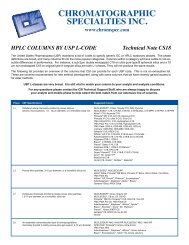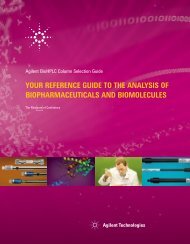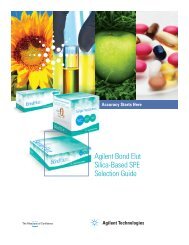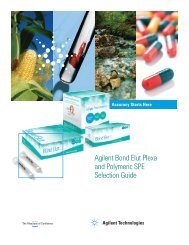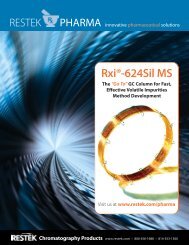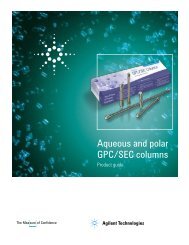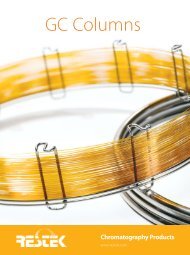Optimizing the Analysis of Volatile Organic Compounds
Optimizing the Analysis of Volatile Organic Compounds
Optimizing the Analysis of Volatile Organic Compounds
You also want an ePaper? Increase the reach of your titles
YUMPU automatically turns print PDFs into web optimized ePapers that Google loves.
Gasoline <strong>Analysis</strong> with Oxygenates and Alcohols<br />
Success <strong>of</strong> gasoline range organics (GRO) analyses are based on <strong>the</strong> ability <strong>of</strong> <strong>the</strong> analytical<br />
column to resolve oxygenates from <strong>the</strong> alkanes, alkenes, and, to a lesser extent, alkynes. To<br />
minimize false positive results for methyl-tert-butyl e<strong>the</strong>r (MTBE) it is important to separate<br />
this analyte from 2-methylpentane and 3-methylpentane. Ano<strong>the</strong>r potential interference is<br />
tert-butyl alcohol (TBA). Both MTBE and TBA elicit response on a PID, and <strong>the</strong>y share<br />
ions used in MS detection, so <strong>the</strong>y must be resolved regardless <strong>of</strong> which detector is used.<br />
Figure 46 is an example <strong>of</strong> GRO target compounds analyzed using PID detection, with <strong>the</strong><br />
oxygen-containing gasoline additives resolved from <strong>the</strong> o<strong>the</strong>r analytes.<br />
Figure 46.<br />
An Rtx ® -VGC column resolves oxygen-containing gasoline derivatives from o<strong>the</strong>r GRO.<br />
1. 2-methylpentane<br />
2. 3-methylpentane<br />
3. methyl-tert-buyl e<strong>the</strong>r<br />
4. tert-butyl alcohol<br />
5. diisopropyl e<strong>the</strong>r<br />
6. ethyl-tert-butyl e<strong>the</strong>r<br />
7. isooctane<br />
8. n-heptane<br />
9. benzene<br />
10. tert-amyl-methyl e<strong>the</strong>r<br />
11. α,α,α-trifluorotoluene<br />
12. toluene<br />
13. 1-chloro-3-fluorobenzene<br />
1 2<br />
4<br />
5<br />
6<br />
3<br />
8<br />
7<br />
9<br />
10<br />
11<br />
14. ethylbenzene<br />
15. m-xylene<br />
16. p-xylene<br />
17. o-xylene<br />
18. isopropylbenzene<br />
19. ethylmethylbenzene<br />
20. 1,3,5-trimethylbenzene<br />
21. 1,2,4-trimethylbenzene<br />
22. 4-bromochlorobenzene<br />
23. naphthalene<br />
24. 2-methylnaphthalene<br />
25. 1-methylnaphthalene<br />
12<br />
13 14<br />
15, 16<br />
30m, 0.45mm, 2.55 m Rtxfi min. 5 10 15 20<br />
GC_EV00465<br />
-VGC (cat.# 19408)<br />
each component 100ppb in 5mL <strong>of</strong> RO water, except tert-butyl alcohol 5000ppb; 2/1-methynapthalene 150ppb;<br />
ethylmethylbenzene 50ppb.<br />
Concentrator: Tekmar LSC-3100 Purge and Trap<br />
Trap: Vocarb 3000<br />
Purge: 11 min. @ 40mL/min. @ 35 C<br />
Dry purge: 1 min. (MCS bypassed)<br />
GC: Finnigan 9001<br />
Oven temp.: 40 C (hold 2 min.) to 130 C @ 6 C/min. (hold 0 min.) to 230 C @ 30 C/min. (hold 2 min.).<br />
Carrier gas: helium @ ~8mL/min.<br />
Detector: Thermo Finnigan PID, make-up 7mL min., purge 7mL/min., set @ 0.35mV, base temperature 200 C.<br />
17<br />
18<br />
19<br />
20<br />
21<br />
22<br />
23<br />
24<br />
25<br />
49<br />
www.restekcorp.com





